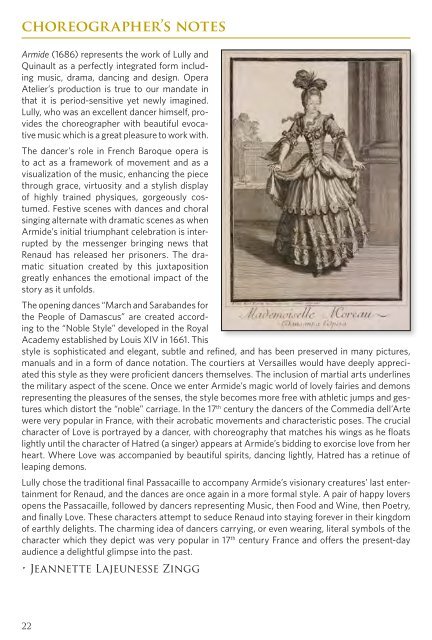October 22 – 31 2015
15077-OperaAtelier-ArmideProgram-WEB
15077-OperaAtelier-ArmideProgram-WEB
You also want an ePaper? Increase the reach of your titles
YUMPU automatically turns print PDFs into web optimized ePapers that Google loves.
Choreogr apher’s Notes<br />
Armide (1686) represents the work of Lully and<br />
Quinault as a perfectly integrated form including<br />
music, drama, dancing and design. Opera<br />
Atelier’s production is true to our mandate in<br />
that it is period-sensitive yet newly imagined.<br />
Lully, who was an excellent dancer himself, provides<br />
the choreographer with beautiful evocative<br />
music which is a great pleasure to work with.<br />
The dancer’s role in French Baroque opera is<br />
to act as a framework of movement and as a<br />
visualization of the music, enhancing the piece<br />
through grace, virtuosity and a stylish display<br />
of highly trained physiques, gorgeously costumed.<br />
Festive scenes with dances and choral<br />
singing alternate with dramatic scenes as when<br />
Armide’s initial triumphant celebration is interrupted<br />
by the messenger bringing news that<br />
Renaud has released her prisoners. The dramatic<br />
situation created by this juxtaposition<br />
greatly enhances the emotional impact of the<br />
story as it unfolds.<br />
The opening dances “March and Sarabandes for<br />
the People of Damascus” are created according<br />
to the “Noble Style” developed in the Royal<br />
Academy established by Louis XIV in 1661. This<br />
style is sophisticated and elegant, subtle and refined, and has been preserved in many pictures,<br />
manuals and in a form of dance notation. The courtiers at Versailles would have deeply appreciated<br />
this style as they were proficient dancers themselves. The inclusion of martial arts underlines<br />
the military aspect of the scene. Once we enter Armide’s magic world of lovely fairies and demons<br />
representing the pleasures of the senses, the style becomes more free with athletic jumps and gestures<br />
which distort the “noble” carriage. In the 17 th century the dancers of the Commedia dell’Arte<br />
were very popular in France, with their acrobatic movements and characteristic poses. The crucial<br />
character of Love is portrayed by a dancer, with choreography that matches his wings as he floats<br />
lightly until the character of Hatred (a singer) appears at Armide’s bidding to exorcise love from her<br />
heart. Where Love was accompanied by beautiful spirits, dancing lightly, Hatred has a retinue of<br />
leaping demons.<br />
Lully chose the traditional final Passacaille to accompany Armide’s visionary creatures’ last entertainment<br />
for Renaud, and the dances are once again in a more formal style. A pair of happy lovers<br />
opens the Passacaille, followed by dancers representing Music, then Food and Wine, then Poetry,<br />
and finally Love. These characters attempt to seduce Renaud into staying forever in their kingdom<br />
of earthly delights. The charming idea of dancers carrying, or even wearing, literal symbols of the<br />
character which they depict was very popular in 17 th century France and offers the present-day<br />
audience a delightful glimpse into the past.<br />
• Jeannette Lajeunesse Zingg<br />
Set DesigN Notes<br />
Armide is a story of the 11th century First Crusade penned as an epic poem by Torquato Tasso in the<br />
Italian Renaissance and transformed by Jean Baptiste Lully and Philippe Quinault in 17th century<br />
France into the tragédie lyrique we present tonight. The designs for Armide grew out of the realization<br />
that independently throughout this period the conflicting cultures in the story developed<br />
the book as a sophisticated art form that communicated much of its message through exquisitely<br />
rendered illustrations and elaborate calligraphy. In Europe the devotional Book of Hours featured<br />
breathtaking illuminations illustrating biblical texts, prayers and psalms while in the Middle East<br />
artists and scribes were creating the glittering, jewel-toned miniatures that beautify the books of<br />
history, legend and poetry that are among the highpoints of artistic achievement in the Islamic<br />
world. These miniatures, so full of intricate pattern and burnished gold became the inspiration for a<br />
set design that treats the stage as an immense book, each scene another page in a story of conflict,<br />
enchantment and thwarted love.<br />
As a departure from my designs for past shows I decided to abandon the forced perspective and<br />
trompe l’oeil paint effects so often seen on the baroque stage in favour of brilliant passages of flat<br />
colour, stylized pattern and Islamic calligraphy (the only European elements are the Christian icons<br />
and military standards captured as trophies by Armide’s armies in the first act). I was fortunate to<br />
work closely with a master Persian calligrapher who translated passages of the libretto for Armide<br />
into elegantly composed panels of graphic script that became integral parts of the design. Even the<br />
house curtain became a “title page” on which a great tughra (the calligraphic emblem traditionally<br />
affixed to Ottoman decrees) announces the names of Armide, Lully and Quinault written in Persian.<br />
While the designs for Armide are created in a Baroque spirit, their stylization would have seemed<br />
strange to 17th century European eyes. Today in a globalized world where information about foreign<br />
cultures can be had at the click of a button and the conflict in the Middle East continues<br />
unabated, this layering of a Middle Eastern aesthetic on a western framework seems to me the<br />
right choice for an opera that treats both cultures as equals and in which the struggle between the<br />
two produces no clear victor.<br />
• Gerard Gauci<br />
<strong>22</strong> 23


